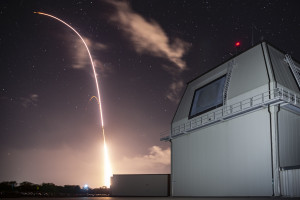A top Defense Department official 0n Tuesday said the department expects to conduct a Standard Missile-3 (SM-3) Block IIA flight test against an intercontinental ballistic missile (ICBM)-representative threat this summer.
The FY 2018 defense authorization act directed DoD to conduct a test to evaluate and demonstrate the capability of the SM-3 IIA missile defense interceptor to defeat a “simple intercontinental ballistic missile threat,” contemplating an additional U.S. mainland defensive capability against a North Korean missile.

This test is occurring in the background of the Missile Defense Agency moving from the canceled Redesigned Kill Vehicle (RKV) to the Next-Generation Interceptor for the Ground-based Midcourse Defense (GMD) missile defense system for the U.S. mainland. The RKV was scrapped due to deficiencies in the program that would have cost hundreds of millions of dollars to fix and a resulting delay of two years.
“To further mitigate the risk in the interim period, we’re going to be looking at conducting a test of the SM-3 Block IIA missile against a North Korean-representative ICBM threat…and we’ll be doing that probably in the summer timeframe,” Deputy Assistant Secretary of Defense for Nuclear and Missile Defense Policy Robert Soofer said during a Hudson Institute video event.
The SM-3 was primarily built as a regional missile defense system designed to intercept medium range ballistic missiles in the midcourse phase of their flight outside the atmosphere. The Block IIA version is a cooperative U.S.-Japan program to increase the range and speed of the interceptor.
“If the SM-3 IIA is capable of intercepting a North Korean-representative ICBM threat, this opens up some possibility to use the SM-3 IIA as an underlay to the GMD system,” Soofer said.
He said after DoD sees if the system works on the new target type, then the department would go back to Congress next year and explain the concept of operations.
“Right now, one could imagine at least deploying these systems on ships where they are already deployed, but will require ships to be in a certain location to be able to intercept this. And it would be really be in the sort of late midcourse terminal phase of flight. In other words, whatever you couldn’t intercept with the GBI you might get another shot with the IIA missile,” he added.
Soofer noted DoD might contemplate putting an SM-3 IIA missile on land as well, similar to the Aegis Ashore systems.
“Ultimately fielding them on ships is not the ultimate answer. I think we probably will need to move them ashore in the same way that we have Aegis Ashore sites in Romania and Poland–we would have similar sites in the United States. I don’t know how many that would number, I don’t know that it would even be in the same configuration as Aegis Ashore…They could be different types of launchers. But you need the interceptor and a radar or sensor to support it either deployed in the United States or forward-based.
Soofer implied DoD is not planning to add a great many new interceptors for mainland defenses as SM-3IIA is sea-based.
“If you look at how many SM-3 IIAs we’re planning to build over the next five years, it’s probably no more than a couple hundred and these are going to be spread amongst the ships, they’re going to deployed in other regions,” he said.